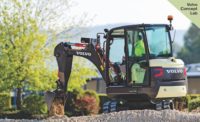A recent upswing in global construction equipment sales has buoyed manufacturers, many of which are now making fresh investments in new technologies. For Volvo Construction Equipment, that means an opportunity to invest in experimental technologies that will help it reach the goals of drastically reducing the rates of accidents, emissions and downtime in the industry.
“We won’t have that typical product development cycle of five to ten years anymore,” says Martin Lundstedt, CEO and president of Volvo Group, which owns Volvo Construction Equipment, in a conversation with trade press on May 19. “The market must do constant iterations with their customers, because to get the benefits of new technology you must work with that production flow to keep up.”
In an effort to show customers what a potential future jobsite might look like, Volvo CE has worked in the last few years on a set of concept machines for what it calls “The Electric Site.” In this concept setting, autonomous and semi-autonomous machines driven almost entirely by electrical power work uninterrupted, with minimum human interference. The concept site was developed with Skanska AB, and is based around the activities of a rock quarry operation in Sweden.
Volvo CE has had several years to work on the concept machines since they were first shown to the public in 2016. But the goal isn’t to take the concept machines from this initiative directly to market, says Melker Jernberg, president of Volvo CE. “Demands from customers are a moving target, so the new launches must be continuous,” he told ENR. “These new technologies will show up in new machines as our customers demand them.”
So while the new HX02 prototype fully autonomous hauler or the electric-hybrid LX01 wheel loader won’t be found on dealer lots anytime soon, advances in battery technology and self-driving assistance may find its way into new Volvo CE machines, explains Jernberg.
But for Lundstedt, the wildest concept vehicles are nothing without user feedback. “Since development is happening so quick on this equipment, how do you know you are relevant? The only way is to have the customer work with you in development,” he says. “We need that dialogue with the customer, otherwise it is just technology for technology’s sake.”






Post a comment to this article
Report Abusive Comment